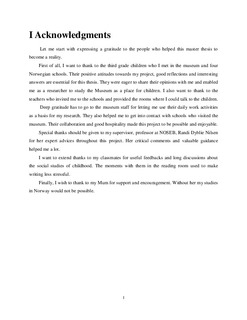| dc.description.abstract | This master thesis is result of the fieldwork done in one of the Norwegian museums and in four Norwegian primary schools. The main informants of the study were third grade children who visited a prehistoric exhibition. The thesis explores the children’s experiences of the museum visit with school class, and children’s perspectives on the prehistoric museum objects. Two main methods were used in order to answer the research questions of the thesis: observations, which were conducted in the museum, and semi-structured group interviews with children, which were conducted in the schools.
The children in this research were seen from the Social studies of childhood point of view. The thesis revealed that museum was a place where children were competent social agents, that in the same time their agency was constrained by museum rules, timetables and curriculum, and that children wanted more agency in the museum. Moreover, study explored that children expressed agency to imagine the prehistory in their own way. The children from the research were also seen as competent human beings who could benefit from the museum visit in their childhoods.
This master thesis explored that children’s experiences of the museum visit were mostly influenced by social context of the visit, or who they were in the museum with. Further, it highlighted that majority of children experienced the museum as a place for learning. Children’s experiences were also influenced by the fact that they were not supposed to be all around the museum, but just in one exhibition room. The stuffed animals in the museum were not part of the curriculum, but an important part of children’s museum experiences.
The children’s interaction with museum objects allowed the author to study children’s perspective on prehistoric times. Children imagined prehistory by using the museum objects and the stories applied to them, which children could see and were told about in the museum. In addition, children used to transform the information about the prehistory to their own everyday’s interests making the new and own story about the prehistory. They were doing that also together with their peers. This master thesis proposes the museum as one more setting where the concepts of interpretative reproduction, peer culture, “human beings and human becomings” and children’s agency could be studied. | nb_NO |
